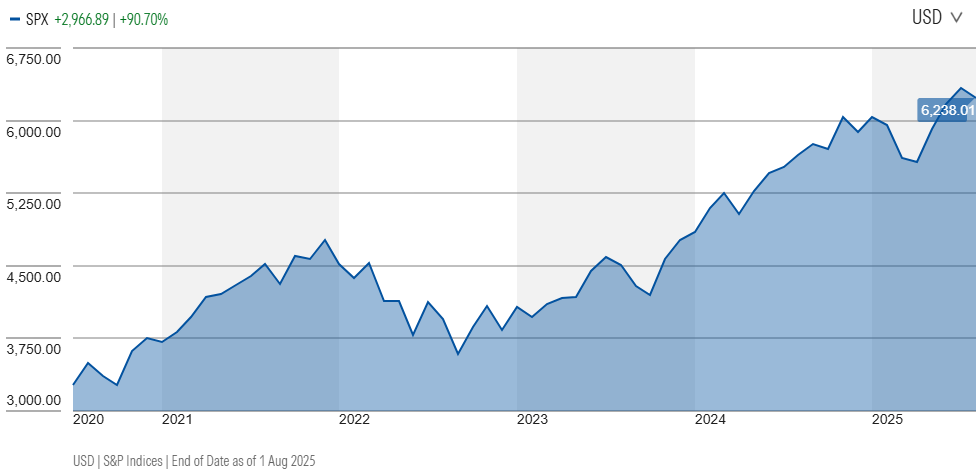Following double-digit gains in 2023 and 2024, the first half of 2025 has witnessed another robust equity market performance, with the S&P 500 hitting record after record highs, driven by mega-cap tech and AI companies. Cooling inflation, positive earnings surprises, and optimistic corporate guidance have fuelled the rally.

Source: Morningstar
The S&P 500’s ascent can be attributed heavily to the gains of tech giants like Nvidia, which boasts tangible earnings, double-digit growth and a forward P/E below 40. Microsoft also just shot the lights out with its latest earnings report. Revenue was up 18% year-over-year to US$76.4 billion, beating estimates by US $2.6 billion. Azure, its cloud powerhouse, grew 39%, outpacing guidance, while Microsoft Cloud now accounts for 61% of revenue, up four percentage points from last year.
This is sharply distinguishable from the pre-revenue start-ups that dominated the dot.com bubble of 1999.
But there are warning signs.
Take declining volatility as an example. At the time of writing, there have been 25 consecutive days without a move in the S&P500 of more than 1%. The market’s calm doesn’t sit well with Trump as president of the United States, tariffs to be reintroduced and the historically more volatile August-October period nearing.
Meanwhile, speculative exuberance in short-dated options, massive trading volumes being attributed to retail trading of penny stocks, and two-day 80% gains in profitless meme stocks suggest the market is morphing from boom to bubble.
Speculative signs include unprofitable Russell 3000 stocks tripling in value, leveraged ETF assets hitting $135 billion, and companies pivoting to bitcoin. High-profile spending, like Jeff Bezos’s €50 million wedding, and doubled penny stock trading volumes reflect exuberance.
With the gains concentrated in a few names, investors should be mindful of the extent to which others are implying an indefinite, undisturbed north-easterly growth trajectory for the earnings of those tech mega-caps. A tech sector stumble (remember China’s DeepSeek?) could trigger market-wide turbulence.
And valuations are stretched. The S&P 500 is at 22 times forward earnings versus a historical average of 18, and the inverse of the PE, the earnings yield, is 4.5% and near a two-decade low relative to real yields.
Elsewhere, the United States is on an unsustainable fiscal path, with its national debt rapidly approaching US$37 trillion.
As hedge fund titan Jeffrey Gundlach recently observed, for the last four decades, when the S&P 500 dropped more than 10%, the US dollar index typically rose. This time, when the S&P 500 fell nearly 20% in April, the dollar fell. The atypical divergence suggests growing market unease about the U.S. fiscal situation.
Moreover, the yield curve is steepening, with the U.S. 10-year Treasury yield rising even as the Federal Reserve began cutting interest rates in September last year. Historically, rate cuts have led to lower yields across the curve, but again, perhaps reflecting anxiety about US debt untenable interest expenses, the 10-year yield has risen.
A core issue is the ballooning cost of servicing the US national debt. The average coupon on U.S. Treasuries has surged from below 1% to nearly 4%, with trillions in bonds maturing and being reissued at higher rates. Bonds issued in 2009 or 2020 with coupons as low as 0.25% are now being replaced at 4.25% - a 400-basis-point increase that exacerbates the budget deficit.
With the national debt climbing US$37 trillion, markets are starting to believe there’s going to have to be something creative such as quantitative easing that targets long-term Treasuries, especially if yields on long bonds rise above 5%.
A valid observation being made is that long-term US Treasuries are losing their status as a “flight to quality” asset. Instead, gold is emerging as a safe-haven asset, and this is reflected in central banks accumulating gold, and retailers like Costco stocking it but selling out.
The problem is that stock market investors are once again taking a long time to notice the paradigm shift. Instead, they’re piling in on a FOMO-inspired momentum bet that history shows always overshoot ahead of a painful reset.
A possible positive, of course, is that debt would be a problem for the U.S. if it were the only country burdened by it. Debt however is a global issue, so investors are right to consider diversifying globally as well as trimming winners in equities and reallocating to funds or securities in other asset classes with less exposure to public markets.
More than any other time in the last four or five years there’s an urgency for vigilance and strategic diversification, not only because geopolitics and economics are uncertain but because market valuations are becoming stretched, evidence of bubble like irrational exuberance is emerging and Trump is still at the helm of the United States, and history says the biggest drawdowns have occurred when Republican presidents are in the Whitehouse.
I am not advocating selling out of stocks, not by any stretch, but it may now be a good time to consider bringing forward any planned rebalancing and using some advised tactical asset allocating to redistribute profits to markets with less exposure to public markets.
Roger Montgomery is the Chairman of Montgomery Investment Management and an author at www.RogerMontgomery.com. This article is for general information only and does not consider the circumstances of any individual.